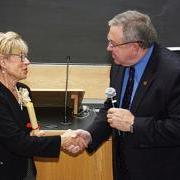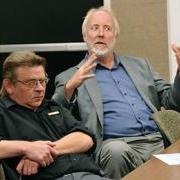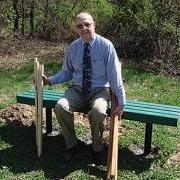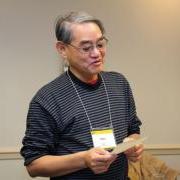|

University at Albany graduate student Olivia Barone figured it was a good time to go back to school for her Ph.D. after she lost her job teaching high school French due to budget cuts.
So the university’s October decision to drop French and four other humanities majors—Italian, Russian, classics and theater—to balance damaging state aid cuts honestly did more than surprise her.
She was shocked.
“We were floored, everyone was completely stunned,” said Barone. “I e-mailed many of my friends with news of the cuts and I must have gotten back 100 responses expressing shock over it,” she continued. “It’s just a bad joke.”
That “bad joke” has received much media coverage since UAlbany President George Philip’s Oct. 1 announcement; the move will help absorb $33.5 million in state aid cuts over the past three years, he said. The story made headlines regionally, nationally and in trade publications such as Inside Higher Ed and The Chronicle of Higher Education. It even got international play; France’s LeMonde newspaper printed a Nov. 2 story titled “American Campuses: French in Decline” (http://bit.ly/i3ZOOj).
“We realize the budget cuts are real, but we think a big mistake has been made,” said UUPer Jean-Francois Briere, a UAlbany French professor and chair of the university’s Languages, Literatures and Cultures department. “Too much has been asked of the College of Arts and Sciences. They are starting to destroy the programs.”
HUMANITIES IN CRISIS?
Are the humanities in trouble? Are they in danger of becoming obsolete for all but those studying at private liberal arts bastions such as Harvard, Yale and Princeton?
Certainly, the humanities are in crisis, with the economy recovering from recession and dwindling public funding for higher ed. But that’s nothing new. The humanities have been in something of a crisis for years; a quick Google search will turn up papers from the 1990s, 1980s and even the 1970s about the humanities facing turmoil.
And while New York Times columnist Stanley Fish, in an Oct. 11 editorial, opined that UAlbany’s decision officially marked “the crisis of the humanities,” the university is the latest in a string of public higher ed institutions that have targeted the humanities to help defray budget cuts.
Humanities majors have been clipped at a number of public institutions, including Arizona State University, Washington State University, the University of Louisiana at Lafayette, Michigan State, and the University of Southern California.
And at least one other SUNY school, Geneseo, will end several humanities programs. In November, the college announced it will phase out majors in art studio and speech language pathology. Also deactivated: majors in computer sciences, and communicative disorders and sciences, according a November budget update on Geneseo’s website (http://www.geneseo.edu/budget_update).
SUNY STABILITY
Despite the moves at UAlbany and Geneseo, it appears there is no plan for a wholesale slashing of humanities programs at SUNY.
No humanities cuts are currently planned at SUNY’s three other university centers—Binghamton University, the University at Buffalo and Stony Brook University. As The Voice went to press, the majority of four-year SUNY schools—including Purchase, Cortland and Buffalo State—weren’t contemplating cuts, according to a phone and e-mail survey by The Voice.
Binghamton has furthered its resolve to protect its humanities programs. In an Oct. 20 letter to faculty and staff, dean and professor of history Donald Neimen said he is “committed to maintain our strength in the humanities and the languages, which are integral to Harpur College.”
Still, humanities programs across the country seem to be wearing a target these days for a number of reasons.
DOLLARS, LITTLE SENSE
Not surprisingly, money is at the root of the evil.
Many schools are focused on offering career-oriented courses of study to attract students seeking marketable skills that quickly pay off come graduation, several academics said. Students and parents have also been pressuring for those courses, understandable considering that 2009 graduates, on average, left school $24,000 in debt, according to study by California-based The Project on Student Debt (http://projectonstudentdebt.org).
And liberal arts graduates have been in decline since the 1960s. Nearly 18 percent of college graduates majored in the humanities in 1966 compared to 8 percent in 2007, according to the Humanities Indicators Prototype, a research project of the American Academy of Arts and Sciences. UAlbany’s Philip cited low enrollment for putting the humanities programs on the chopping block.
UUP President Phil Smith was quick to come to the defense of the humanities, which are an integral part of a college education.
“The difference between a university and a trade school in many ways is a liberal arts education,” he said. “In the long run, the humanities may be a student’s most valuable experience. They teach how to think and reason, and raise questions, which can be applied in every aspect of your life.”
“What we are seeing today is the vocationalization of higher education,” Ellen Schrecker, author of The Lost Soul of Higher Education: Corporatization, the Assault on Academic Freedom, and the End of the American University, said in an Oct. 20 article in Inside Higher Ed. “That’s what students and their parents supposedly want, especially at a time when they view college as an investment that should lead to an immediate economic pay-off. But that kind of short-term thinking is damaging—to students, to higher education, and to society as a whole.”
UUPer Bill Cook, a longtime Geneseo history professor, and veteran Albany Chapter Vice President for Academics Ivan Steen said a liberal arts degree can and often does pay off in the job market. Employees want workers who can think creatively, reason through problems and have an understanding of the world around them.
“You simply can’t equate degrees in something technical with being ready to get a job,” said Cook. “The skills they carry with them from job to job are that they can write and think, if they have a good mind and are able to learn. Those qualities are what the humanities bring to higher education.”
Yet, colleges are feeling pressure from many sides, and private sector grants and corporate funding for science and technology courses are hard to turn down these days. Humanities courses traditionally aren’t the funding draws that science and technology – and even athletics – are for a college, which can open them to potential budget cuts, academics said.
“It’s a trend in this country to look at universities as business corporations,” Steen said. “Our role as a university is to turn out educated people, and when you take basic humanities out of the mix, you’re turning out people who are narrowly trained.”
NEVER SAY NEVER
At UAlbany, UUPers, students, parents, alumni and staff continue to resist the cuts. A petition signed by more than 13,200 people— including signers from 37 countries—protesting the cuts was submitted to administrators Nov. 3. That was followed by an Oct. 7 campus rally that drew 200 students, faculty and staff in support of keeping the courses.
And in November, UAlbany’s faculty senate voted on three measures to condemn the program suspensions; Philip has said he will consider the vote before the suspensions are made final, Briere said.
“We will do everything in our power to preserve those important humanities courses,” said Albany Chapter President Candy Merbler.
HUMANITIES WILL SURVIVE
While the humanities at UAlbany have hit a rough patch, Briere, Steen and Cook said they don’t believe it’s the beginning of the end for liberal arts. The way the courses are delivered may change, but the humanities will always be at the core of higher education.
As proof, they pointed to Harvard’s commitment to use a $10 million donation for humanities, and Cornell University president David Skorton’s November announcement to launch a national campaign to advocate for the arts and humanities. The University of Pittsburgh opened its new humanities center this year, and the University of Connecticut recently broke ground on a new humanities center.
“I’m not worried that in the long run the humanities will be reduced to a footnote in the 21st century,” Cook said. “We have to realize that things are going to change in the way we present things. I mean, try to find someone who studied Islam 40 years ago.
“There have been great shifts and economic crises before and the humanities have always been resilient,” he continued. “After all, life is so much more interesting when you include the dead in your conversations.”
— Michael Lisi
|











